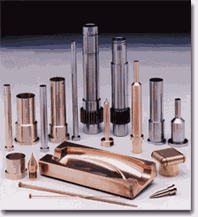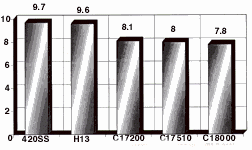
|

...World Wide Distributor of Beryllium-Free Copper Alloys...
Manufacturer of Standard & Custom Components
![]()
Site Updated Often! To ensure proper viewing please Refresh page &
MAKE SURE YOUR BROWSER IS SET TO UPDATE AT EACH VISIT
![]()
How We Stack Up To The Competition!!
| In 1995 a Mold Task Force group was
organized by the Copper Development Association to promote the use of copper alloys in
molds for plastics. Part of the activity of the group and the CDA was to fund research projects at Western Michigan University to compare popular mold steels with beryllium copper and our beryllium-free copper alloys. The mold components made from the various materials were carefully engineereed and constructed to eliminate any potential for variation that might be caused by the tooling itself. The initial testing focused on cycle time reduction, quality changes and component performance. The tests were to observe those conditions by varying the mold core material combined with reductions to mold cool time only. The tests were strictly controlled to insure that there were no changes to water temperature, water flow rates, injection rate and the mold open time. In April 1996, results were published by the Western Michigan University that showed our Beryllium-Free C18000 (MoldStar™150) alloy performed consistently better than the beryllium copper alloys used in the tests. In fact, our alloy performed consistently 7% faster than the C17510 Beryllium Copper alloy. Along with faster cycles the part proved better by quality observations. The differences in cycle times between C17510 and C17200 were less than 5%. These test results are extremely important to people using or considering using C17510 and C17200. Why? One must also wonder then what other claims in their advertising are not totally accurate or truthful. |
Seconds 
Results As Published By Western Michigan University For Antec 96
|
|
|
|
Copyright © 1998-2014 by Performance Alloys &
Services, Inc |
